Contemporary Church History Quarterly
Volume 21, Number 4 (December 2015)
Ferdinand Schlingensiepen and the Quest for the Historical Bonhoeffer
By Kyle Jantzen, Ambrose University
The Quest for the Historical Bonhoeffer [1]
In recent years, the field of Bonhoeffer studies has been dominated by debates about two biographies: Eric Metaxas’ Bonhoeffer: Pastor, Martyr, Prophet, Spy and Charles Marsh’s Strange Glory: A Life of Dietrich Bonhoeffer.[2] While members of the popular media and Christian commentators have generally lauded these stylish works, historians of the period as well as many Bonhoeffer scholars have generally been critical of them.
One of the reasons for this difference of opinion, argue Victoria J. Barnett and Andrew Chandler, is that many recent interpretations of Bonhoeffer have been driven by theology rather than history. As a result, often “the dramatic historical events of Bonhoeffer’s era and the individuals he encountered in ecumenical, political, church, and resistance circles serve primarily as the backdrop for the poignant personal and theological story that is center stage.”[3] Related to this is the mythology which quickly grew up around Bonhoeffer in the years after the war, when his books Cost of Discipleship and Letters and Papers from Prison established him as a serious biblical Christian and martyr, both of which were especially attractive to a North American audience. For better or worse, Bonhoeffer has received more attention than his historical roles in the German church struggle, resistance, or ecumenical world would merit. It is surely the power of his life, writing, and testimony that has accomplished this, thanks in good measure to the tireless efforts of his best friend and biographer Eberhard Bethge. Still, it means he is an easy figure to lift out of his historical context. Finally, a third factor which influences recent interpretations of Bonhoeffer is the contemporary prominence of Holocaust studies, which tempts authors to make the subject of Jewish persecution and annihilation more important to Bonhoeffer and other Protestant leaders than it actually was back in the day.[4] As Stephen Haynes argued in his 2004 work The Bonhoeffer Phenomenon: Portraits of a Protestant Saint, theological radicals, liberals, and conservatives have all identified Bonhoeffer as one of their own, a tradition only continued by Metaxas and Marsh.[5]
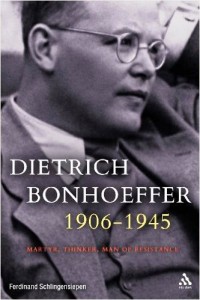 Lost in all of the attention paid to Eric Metaxas’ Bonhoeffer: Pastor, Martyr, Prophet, Spy is the fact that an English-language translation Ferdinand Schlingensiepen’s 2006 biography of Bonhoeffer was also published in 2010.[6] Dietrich Bonhoeffer 1906-1945: Martyr, Thinker, Man of Resistance is surprisingly unknown and seldom reviewed. Even this journal—dedicated to twentieth-century German church history and replete with Bonhoefferiana—failed to assess either the original German version or the subsequent English translation. Nor can this oversight be explained on account of any inadequacy in the qualifications of the author or the quality of the research. The following analysis is both a compensation for the absence of a more timely review and an attempt to reconcile differing views of Bonhoeffer through a close analysis of Schlingensiepen’s work.
Lost in all of the attention paid to Eric Metaxas’ Bonhoeffer: Pastor, Martyr, Prophet, Spy is the fact that an English-language translation Ferdinand Schlingensiepen’s 2006 biography of Bonhoeffer was also published in 2010.[6] Dietrich Bonhoeffer 1906-1945: Martyr, Thinker, Man of Resistance is surprisingly unknown and seldom reviewed. Even this journal—dedicated to twentieth-century German church history and replete with Bonhoefferiana—failed to assess either the original German version or the subsequent English translation. Nor can this oversight be explained on account of any inadequacy in the qualifications of the author or the quality of the research. The following analysis is both a compensation for the absence of a more timely review and an attempt to reconcile differing views of Bonhoeffer through a close analysis of Schlingensiepen’s work.
In his own review of the Metaxas and Marsh biographies, Schlingensiepen echoes the criticisms of Clifford Green,[7] Victoria J. Barnett,[8] and others. Moreover, he sums up the German scholarly frustration with the two American interpretations:
Marsh and Metaxas have dragged Bonhoeffer into cultural and political disputes that belong in a U.S. context. The issues did not present themselves in the same way in Germany in Bonhoeffer’s time, and the way they are debated in Germany today differs greatly from that in the States. Metaxas has focused on the fight between right and left in the United States and has made Bonhoeffer into a likeable arch-conservative without theological insights and convictions of his own; Marsh concentrates on the conflict between the Conservatives and the gay rights’ movement. Both approaches are equally misguided and are used to make Bonhoeffer interesting and relevant to American society. Bonhoeffer does not need this and it certainly distorts the facts.[9]
As his comments suggest, Schlingensiepen’s approach to the Bonhoeffer story is shaped very much by his own history in the German Protestant church. It would be hard to find a scholar with better credentials for writing a Bonhoeffer biography. Ferdinand Schlingensiepen’s father Hermann was a Confessing Church pastor who knew Bonhoeffer, who directed one of the Confessing Church seminaries, and who participated in the German church struggle. A pastor and theologian himself, Ferdinand maintained a close, fifty-year friendship with Eberhard Bethge, Bonhoeffer’s confidante and biographer. Indeed, in the Acknowledgements, the author notes that Bethge realized his thousand-page biography was too long for most readers and asked Schlingensiepen to compose a shorter version which would update his own interpretation. Moreover, Schlingensiepen worked for former Confessing Church leader Kurt Scharf for a decade, knew various members of the extended Bonhoeffer clan, and employed the same editor as Bethge had worked with in the completion of his magisterial biography decades earlier.
All this makes Schlingensiepen intimately aware of the context in which Dietrich Bonhoeffer lived, learned, served, thought, wrote, and acted. His rich contextualization of Bonhoeffer influences the biography in two ways: first, Bonhoeffer is understood not as a lonely genius but in relationship to the many family members, friends, mentors, and colleagues who enriched in his life; second, Bonhoeffer’s theology and politics are developed in close connection to the German church struggle.
Bonhoeffer’s People
Schlingensiepen has much to say about the many people who contributed to Bonheffer’s life. His parents Karl and Paula and siblings Karl-Friedrich, Walter, Klaus, Ursula, Christine, Sabine, and Suzanne nurtured him, inspired him, failed to understand his decision to study theology, travelled with him, conspired with him against Hitler, advised him, corresponded with him, and supported him during his final years in prison. So too did his in-laws from the Delbrück, Dohnanyi, Schleicher, Leibholz, and Dreβ families. Indeed, Bonhoeffer’s entrance into the resistance movement is inconceivable without his family connections, and in particular those of brother-in-law Hans von Dohnanyi, assistant to federal justice minister Franz Gürtner, brother Klaus Bonhoeffer, a high-ranking lawyer for Deutsche Lufthansa, brother-in-law Rüdiger Schleicher, an important official in the air travel ministry, and uncle Paul von Hase, a high-ranking army officer and the city commandant of Berlin.
Beyond immediate and extended family members, Schlingensiepen weaves a host of other characters into his Bonhoeffer biography. He describes Superintendent Max Diestel as the “discoverer of Bonhoeffer” who watched over his theological development, sent him abroad for life-changing experiences in ministry and education, and introduced him to ecumenical work (33-34). In Schlingensiepen’s account of Bonhoeffer’s time at Union Seminary in New York, the author focuses on four deeply influential friends, both at that time and later. Paul Lehmann, an American of German-Russian ancestry, developed a friendship with Bonhoeffer that lasted from their student days to the war years, even though Bonhoeffer resisted his plea to stay in the United States in 1939 (63-64, 70, 230, and 267). Frank Fisher was the American student who introduced Bonhoeffer to the vibrant but marginalized black church in New York (65, 70). Erwin Sutz was a Swiss student who introduced Bonhoeffer to Karl Barth and became both an ecumenical partner and a vital communication link for Bonhoeffer in Switzerland during the war (67-70, 87-88, 262). Finally, Jean Lasserre, a French student at Union Seminary, profoundly influenced Bonhoeffer’s thinking about both pacifism and the Sermon on the Mount and became a long-running partner in international and ecumenical dialogue (70-73, 93, 173-174).
As Schlingensiepen explains Bonhoeffer’s life, thought, and work, there are scores of other influential and often overlooked characters who make their appearances: scholars like Adolf von Harnack, Reinhold Seeberg, and especially Karl Barth; friends and coworkers like Franz Hildebrandt, Hermann Sasse and Wilhelm Vischer, Gertrud Staewen, Julius Rieger, and of course Eberhard Bethge; ecumenical contacts like Wilhelm Visser’t Hooft and Bishop George Bell; the patron Ruth von Kleist-Retzow; and Bonhoeffer’s students from Finkenwalde. Whether he was developing his theology, writing confessional statements, combatting German Christian opponents in the church struggle, educating theology students, engaging in ecumenical dialogue, or resisting Hitler, Bonhoeffer never worked alone. Schlingensiepen always places him among people and regularly shows how dependent Bonhoeffer was on others.
Several examples illustrate this. In the summer 1933, though the formulation of the Bethel Confession was assigned as a joint project to Dietrich Bonhoeffer and Hermann Sasse, Schlingensiepen points out how it was in fact Swiss Old Testament scholar Wilhelm Vischer who contributed the vital section on the people of Israel (134-136). Similarly, the author notes that while Martin Niemöller and twenty other pastors (Bonhoeffer included) founded the Pastors’ Emergency League later in 1933, the idea actually came from two country pastors, Eugen Weschke and Günter Jacob (137).
In 1934, Bonhoeffer spent much of his time combatting August Jäger, state commissioner for the Prussian provincial churches and the violent implementer of the German Christian takeover of the Old Prussian Union Church and attempted creation of a centralized, authoritarian Reich Church. As Martin Niemöller and the Pastors’ Emergency League fought against Jäger’s boss, German Christian leader and Reich Bishop Ludwig Müller, Bonhoeffer agitated in the same direction from London, where he was pastoring. Here Schlingensiepen introduces Bishop George Bell of Chichester, who supported Bonhoeffer by writing German President Hindenburg about Müller and Jäger. Schlingensiepen explains how Bonhoeffer wrote forcefully but unsuccessfully to his ecumenical partners in Geneva, asking them to oppose the Müller regime. It was then that Bell, who was president of the Universal Christian Council for Life and Work, sent around a pastoral letter to the member churches of the Council, denouncing the radical unconstitutional seizure of authority in various provincial churches in Germany. Subsequently, after the Barmen and Dahlem Synods, it was the initiative of Bell and through him also the Archbishop of Canterbury—both of whom spoke in person to the German ambassador to England—that pushed Hitler’s government into jettisoning Jäger (152-154, 158-160, and 164-167).
Schlingensiepen also shows Bonhoeffer’s connections to key women in this history who are generally overlooked by other Bonhoeffer scholars. First, when Bonhoeffer began teaching theology in the Confessing Church seminary in Finkenwalde, he met and became friends with Ruth von Kleist-Retzow. She was a Pomeranian noblewoman who went on to introduce him to local aristocrats, to substantially support the underfunded seminary, and to open her home to Bonhoeffer for holidays and writing retreats (180, 244, 247, and 281). Finally, in 1941, after Bonhoeffer heard about various Jewish rescue operations from his ecumenical friends in Switzerland, he returned to Berlin and told close friends about them. Among these was Gertrud Staewen, who had been his friend since the two had worked together with Karl Barth, advocating on behalf of persecuted theology professor Günther Dehn in 1931 and protesting at the Protestant National Synod in 1933 (101, 141). Schlingensiepen suggests that Bonhoeffer asked Staewen to serve as the key link in the rescue of Berlin Jews sometime in the summer of 1941—in short, to take over the work of Heinrich Grüber and Werner Sylten, both of whom had been thrown into concentration camps. Based on her correspondence, Staewen accepted this call, working together with others in Berlin to support Jews being deported and to help some of them go underground. As part of this work, she maintained regular contact with ecumenical partners in Switzerland and with Bonhoeffer, who encouraged her but could not participate in the rescue work directly, because of his involvement in the resistance (263-264). These are just a few examples of the many ways in which Ferdinand Schlingensiepen places Dietrich Bonhoeffer within the larger context of activists engaged in church-political battles, theological writing and training, and subversive political activities.
The German Church Struggle
The second noteworthy aspect of Schlingensiepen’s contextualization of Bonhoeffer is in the careful attention he pays to the German church struggle, from the Nazi seizure of power and rise of the German Christian Movement in 1933 to the end of Bonhoeffer’s leadership of the Finkenwalde seminary in 1937. The author writes of “the many fronts on which [Bonhoeffer] was fighting and the many groups of people with whom he wrestled, … a bewildering abundance of events.” Significantly, he argues that “it was during the chaotic, fateful year, 1933, that the course was set for the 12 years of Hitler’s dictatorship, and thus for everything that was to follow in Bonhoeffer’s life” (116). Having established the significance of events in 1933, Schlingensiepen goes on to describe the events of the church struggle in their necessary detail, avoiding the confusion that so often accompanies this conflict. The author begins with Bonhoeffer’s leadership speech of February 1, Hitler’s seizure of power, the rise of the German Christian Movement, and Bonhoeffer’s essay on “The Church and the Jewish Question,” in which he proposes three possible responses to state injustice: to call the state to account, to give aid to the victims, and ultimately, to not only “bind up the wounds of the victims beneath the wheel, but to seize the wheel itself” (126). The politics of the Young Reformation Movement, the rise of Martin Niemöller, the church constitution issue, the takeover of the Old Prussian Union Church government, the church elections of July 1933 and German Christian seizure of Protestant church governments, the emergence of an opposition movement, the drafting of the Bethel Confession, the fall 1933 Prussian and national church synods, and the formation of the Pastors’ Emergency League—all these are given appropriate attention in a single chapter on the year 1933.
From there, Schlingensiepen goes on to describe Dietrich Bonhoeffer’s service as pastor in London and then as director of the Confessing Church seminary in Finkenwalde. At the same time, however, he explains Bonhoeffer’s participation in the church struggle, including the campaign against the Reich Church and Reich Bishop Ludwig Müller, the Barmen Declaration and the formation of the Confessing Church, the establishment of church finance departments in the Prussian provincial churches, the appointment of Hanns Kerrl as Minister of Ecclesiastical Affairs, Kerrl’s attempt to govern the churches through Reich and provincial church committees, and the appointment of Dr. Friedrich Werner as director of the German Protestant Church chancellery and head of the Berlin High Church Council.
Especially noteworthy is Schlingensiepen’s understanding of the relationship between the Barmen, Dahelm, and Oeynhausen Synods of the Confessing Church. For Bonhoeffer and his colleagues, “the decisions of Dahlem were just the necessary ‘form’, the ordering of the Church required by the ‘content’ of the Theological Declaration of Barmen” (165). Indeed, the author argues that “there was no one in the Confessing Church who took the decisions of the Confessing Synod of Dahlem more seriously than did Bonhoeffer” (172). Bonhoeffer consistently refused to recognize the authority of the official church governments, emphasizing that the Confessing Church was the sole legitimate church government and even applying the old formula extra ecclesiam nulla salus to the situation: “Whoever knowingly separates himself from the Confessing Church separates himself from salvation” (189). He would not even make peace with Kerrl’s more moderate church committees taking the radical position that “Barmen [was] a tower against the subversion of church doctrine, Dahlem the tower against the subversion of the ecclesiastical order,” and Oeynhausen “our defence against the subversion of the church by the world as, in the shape of the Nazi state, it intervenes through its finance departments, Legislative Authority and committees, and is now tearing into separate groups the church of those who confess our faith. Here we cannot and must not give in one single time!” (194). This aspect of Schlingensiepen’s account is particularly important, since the divisions within the Confessing Church between Lutherans in the “intact churches” of Württemberg, Bavaria, and Hanover who were willing to work with the German Protestant Church government and the Dahlemites who rejected any authority outside the Confessing Church are often misunderstood or ignored. And it is precisely here that we see the radicalism of Bonhoeffer, rejecting both the enthusiasm of the German Christian Movement to fuse Nazism and Christianity and the unwillingness of the Lutheran wing of the Confessing Church to abandon the state church tradition of German Protestantism. Schlingensiepen helps us to make sense of Bonhoeffer’s theological and existential journey through the events German church struggle.
The Historical Bonhoeffer
But who is Schlingensiepen’s Bonhoeffer? The author’s short answer is that Bonhoeffer’s life, actions, and death cannot be explained solely according to traits he inherited, but must take into consideration his formation as a youth at home and in university. Above all, Schlingensiepen sees three key characteristics in Bonhoeffer: “intellectual curiosity, an incorruptible sense of right and wrong, and the courage to make uncomfortable decisions with potentially dangerous consequences” (xviii-xix). Moreover, he argues we must also:
become engaged with what, for Bonhoeffer, theology was. Bonhoeffer wanted to expose theology to ‘the fresh air of modern thinking’. He insisted that the message of the Church must always apply concretely to the reality of the world. Timeless truths he considered useless, for ‘what is always true is precisely what is not true today’. (xix)
This is what is so striking about Schlingensiepen’s Bonhoeffer. His combination of curiosity, moral courage, and theological creativity makes him so utterly unpredictable, so full of paradoxes (perhaps even contradictions), and so impossible to pigeonhole.
Bonhoeffer’s Formation
Bonhoeffer’s formation surely contributed to this. He grew up in upper middle class privilege, steeped in the education and culture of a professional family. While he lost an older brother in the First World War, his own wartime service was as a 12 year-old “messenger and food scout” for the family, secretly participating in the black market trading of which his siblings disapproved (11). From an early age, he was independent minded, and surprised his non-church going family by choosing to study theology (16). Time and again, Schlingensiepen highlights the unconventional and unpredictable aspects of Bonhoeffer’s journey, whether it was joining the non-conformist Hedgehog fraternity at Tübingen or quitting the group when they expelled their Jewish members (19). Later, this independent streak showed itself in his choice of Reinhold Seeberg as his doctoral supervisor, even though Bonhoeffer had worked far more closely with Adolf von Harnack, and though Seeberg had little time for Bonhoeffer’s interest in Karl Barth’s doctrine of revelation (29-30).
Bonhoeffer’s formation continued along unconventional lines. Already while an undergraduate, he had travelled throughout Italy and down into North Africa, experiencing both Islam and Roman Catholicism. Indeed, it was Bonhoeffer’s exposure to Catholic worship in Rome that fuelled his growing interest in ecclesiology (22-25). Then, following the completion of his doctorate in 1927, Bonhoeffer experienced more of the world, serving as a pastoral assistant in a German congregation in Barcelona for a year, then studying at Union Seminary in New York for another year. There he encountered the friends who introduced him to African-American Christianity and pacifism. During this time he travelled widely in the United States and Mexico, experiencing cultures far outside his own. And even before he went to America, he had also contemplated the idea of travelling and studying in India, in part due to the suggestion of his grandmother, who believed it would give him the benefit of a non-Western and non-Christian perspective (61). Later, of course, Bonhoeffer would continue to travel widely on behalf of the ecumenical movement, giving him relationships, experiences, and perspectives far different from those of most German Protestant clergy. Once again in 1934 he thought of India, and even received an invitation from Gandhi (171). In the fateful year of 1939, he journeyed a second time to the United States, only to break off his stay and return to Germany in order to be present during the crises in church and nation.
Radical Thinking
For Schlingensiepen, this combination of personality, upbringing, and educational formation lies behind Bonhoeffer’s habit of pursuing radical theological ideas and church-political positions. As early as 1928 in Barcelona, Bonhoeffer lectured on the need for an all-or-nothing decision concerning Christ in “the most profound matters we are facing, namely, concerning our own lives and the life of our people” (49). When he turned to the question of ethics, he argued that moral decisions involved the consciousness of the commandments of God, the watchful eye of God, and the grace of God in each moment of life. For Bonhoeffer, ethics were, from the beginning, about doing the right thing in every unique circumstance, not about following abstract principles. As he put it:
There are no acts that are bad in and of themselves; even murder can be sanctified. There is only faithfulness to or deviation from God’s will. There is no law with a specific content, but only the law of freedom, that is, bearing responsibility alone before God and oneself (49-50).
Bonhoeffer carried this same radicalism into 1933 and the events of the church struggle, whether in his February radio speech denouncing Hitler’s style of leadership as seductive and idolatrous (117), in his judgment that German Protestants had “totally lost both their heads and their Bible” when it came to the Jewish question (121), or in his now famous assertion that the church might have to “seize the wheel” and engage in the direct political action of resisting the unjust state (126). In a public debate at the University of Berlin, Bonhoeffer was the lone representative of the Young Reformation Movement, facing groups of professors and students from the German Christian Movement and the church-politically neutral camp before an audience of 2000 (131). In early summer, he and his friend Franz Hildebrandt even proposed a Protestant interdict—a collective refusal to perform Protestant funeral services until the church’s legal rights were restored. When their shocked colleagues refused to consider the idea, the two men considered leaving the church (132). Still in 1933, Bonhoeffer described the application of the antisemitic Aryan paragraph in the church as a false doctrine and (with friends) distributed protest leaflets at the Protestant National Synod in Wittenberg in September (137, 141).
By the beginning of 1934, by which time Bonhoeffer had taken up pastoral duties in two German congregations in London, he had begun to adopt a prophetic tone concerning the crisis in German Protestantism (154). He fully embraced the radical stance of the October 1934 Dahlem Synod’s resolution that “the constitution of the German Evangelical Church has been destroyed” and that “the Confessing Synod of the German Evangelical Church creates new organs of leadership” (165). At the ecumenical Youth Conference in Fanø that same year, Bonhoeffer mobilized his students to pass a resolution stating “that the rights of conscience, undertaken in obedience to God’s Word, exceed in importance those of any State whatever.” A second resolution noted that the state has attempted “to become the only centre and source of spiritual life,” asserted that the church and not the state must preach the Word of God, and concluded that “the Church works within the nation, but it is not ‘of the nation’” (169). At the main ecumenical conference in Fanø, Bonhoeffer argued forcefully that “the work of the World Alliance means work of the Churches for peace amongst the nations. Its aim is the end of war and the victory over war.” In a sermon at the conference, he continued on this same theme: “What God has said is that there shall be peace among all people—that we shall obey God without further question, that is what God means. Anyone who questions the commandment of God before obeying has already denied God” (171).
Throughout the balance of the church struggle, Schlingensiepen portrays Bonhoeffer as firm in his uncompromising radicalism. He drew more and more on the Sermon on the Mount as the basis of his thinking, adopted elements of monasticism as the basis for his seminary work at Finkenwalde, argued that there could be no salvation outside the Confessing Church, refused to participate in the moderate process of church committees, looked ahead to a “coming of resistance ‘to the point of shedding blood’,” and emphasized that the obedience and belief will lead the Christian into the image of Christ, including the image of suffering and martyrdom (173-174, 182, 189, 193-194, 198, 207-208). Furthermore, he prepared to refuse an expected call into military service (with the possibility of a death sentence) and sharply rebuked Confessing Church pastors who swore an oath to Hitler in 1938 (208, 212).
In contrast to his uncompromising moral and theological resolution, Bonhoeffer found personal decision making difficult. He often wavered, feeling “again and again that all the decisions I had to make were not really my own” (39). This was true of his time abroad in Barcelona and New York between 1929 and 1931, and again in 1939 when he briefly returned to the United States. He couldn’t identify exactly why he promptly returned to Germany, but was convinced the decision was in God’s hands (230). He saw himself as a sojourner on God’s path (235, 236). This was also true of his decision to enter the resistance and the conspiracy to assassinate Hitler. More and more he came to understand that “with God we do not take up a stance—we walk along a path. It goes forward, otherwise we are not with God. God knows where the path goes, throughout its length; we know only the next step and the ultimate destination” (294).
With the beginning of his knowledge about German resistance plans, beginning in 1938, Bonhoeffer entered a new phase, theologically. Much of this is reflected in his work on Ethics, and appears in his many reflections Schlingensiepen includes on decision making, ethics, and Christian responsibility. For instance, in rejecting inner migration as a response to the early successes of Hitler’s armies in the Second World War, Bonhoeffer embraced instead an earthy, situational view of ethics. For him, the world had been reconciled to God by Christ and God had chosen to fundamentally accept the world. As a result, Schlingensiepen explains, the world “can become the place in which human beings assume responsibility, make peace, protect life and overcome murder, violence, and atrocities.” Bonhoeffer did not pursue “principles, standards or duties as eternally valid,” but encouraged people “in every historical situation, to listen anew to God’s commandments and to follow Christ” (251). As a result, Bonhoeffer could both accept the necessity of the removal of Hitler by assassination and reject the euthanasia of handicapped Germans on the basis of the commandment not to kill. The key to this was Bonhoeffer’s radical understanding of freedom. As the theologian put it:
Jesus stands before God as the obedient one and as the free one. As the obedient one, he does the will of the Father by blindly following the law he has been commanded. As the free one, he affirms God’s will out of his very own insight, with open eyes and a joyful heart; it is as if he re-creates it anew out of himself. (251)
Later, as Bonhoeffer became more deeply enmeshed in the resistance, his brother-in-law and close friend Hans von Dohnanyi asked him about the permissibility Christian participation in murder, since God’s law condemned it. Schlingensiepen summarizes Bonhoeffer’s response: “Murder is still murder, even when, in the case of Hitler, it is absolutely necessary. One must be prepared to take the guilt for this sin upon oneself. Bonhoeffer added that if he could get near enough to Hitler, he would throw the bomb himself” (274). This corresponded with his earlier advice to General Hans Oster, a fellow resister, that treason could be morally necessary if it prevented further criminal atrocities as were taking place in Poland. Still Bonhoeffer was not without his doubts. He wondered whether he could still function as a pastor, if he was among those with Hitler’s blood on their hands.
Continuing his discussion of Bonhoeffer’s thinking about guilt and responsibility, Schlingensiepen quotes the famous section in Ethics in which Bonhoeffer confesses the guilt of the church—the guilt of leaving undone what should have been done, and of doing what should not have been done:
The church confesses that it has witnessed the arbitrary use of brutal force, the suffering in body and soul of countless innocent people, that it has witnessed oppression, hatred and murder without raising its voice for the victims and without finding ways of rushing to help them. It has been guilty of the lives of the Weakest and most Defenceless Brothers and Sisters of Jesus Christ. (277)
For Bonhoeffer, this sense of responsibility and need to confess was rooted in the relationship between obedience and freedom. As one who knew those involved in the assassination plot, he wrote about “the freedom of those who act responsibly,” declaring “there is no law behind which they could take cover. … Instead, in such a situation, one must let go completely of any law, knowing that here one must decide as a free venture” (281). The free and responsible person breaks the law, recognizes his guilt under the law, and so affirms the law.
During this time, and from 1943 on, when he was in prison, Bonhoeffer’s ethics evolved into a new understanding of Christianity. In this “journey to reality,” Bonhoeffer entered what Bethge called a “turning point from Christian to man for his times.” He focused increasingly on concepts like “earth,” “reality,” and “world,” which he meant in a positive sense (293-295). He amazed himself “that I am living, and can live, for days without the Bible,” at other times drinking in Scripture, but all the while growing in “opposition to all that is ‘religious.’” He added, “But I must constantly think of God, of Christ; authenticity, life, freedom and mercy mean a great deal to me. It is only that the religious clothes they wear make be so uncomfortable” (295).
Schlingensiepen devotes a good deal of attention to these developments in Bonhoeffer’s thinking, which culminated during his time in prison. Even as his romantic relationship with his eventual fiancée Maria von Wedemeyer was growing, even as his captors continued to interrogate and torture him, Bonhoeffer worked on theology for what he called a “religionless” time (349). Schlingensiepen insists this was not the product of the earlier prison shock which had tempted him to consider suicide as a kind of ethical extension of his resistance (324). Rather, it was a new forward-looking orientation, by which he understood that the gospel was always turned towards the whole world. Here Schlingensiepen quotes his own father, who reflected on Bonhoeffer’s prison writings after the war: “This world is, even though at enmity with God or far away from God, still the world that God loves. So there can only be a church which turns toward the world” (351). Bonhoeffer himself wrote of blessing the world, declaring its belonging to God, even as the world inflicts suffering on the Christian.
Schlingensiepen explains that for Bonhoeffer, the core question which emerged was “what is Christianity, or who is Christ actually for us today?” (351). In his prison letters, Bonhoeffer began to wrestle with the concept of “religionlessness.” For him, the conduct of the German churches during the Nazi period was one more factor that invalidated traditional religious language. Beyond that, however, the older problem of the church’s refusal to face modern science and its explanations of the world apart from any reference to God meant that the church was always on the defensive, always turning God into a God of the “stopgap.” Grappling with what it meant to live in such a world come of age, he argued for the need to bring God into this very place of worldliness: “The same God who makes us live in the world without the working hypothesis of God, is the God before whom we stand continually. Before God, and with God, we live without God.” In this context, Bonhoeffer understood God as near, as suffering, as weak. Continuing, he wrote: “God consents to be pushed out of the world and onto the cross, God is weak and powerless in the world, and in precisely this way, and only so, is at our side and helps us” (353). Schlingensiepen explains that, in his religionless Christianity, Bonhoeffer understood Jesus in the idea of presence. “Being-for-others” was both the essence of Jesus and the calling of the Christian who would live in faith (353-354).
Conclusion
There are many other rich thematic veins to be mined in Schlingensiepen’s Dietrich Bonhoeffer 1906-1945 which I have only touched on: Bonhoeffer’s consistent peace ethic; his pastoral activity; his ecumenical journeys to England, Switzerland, and Sweden; his approach to theological education; his participation in the rescue of Jews; his friendship with Eberhard Bethge; his romance with Maria von Wedemeyer; his doubt- and confidence-filled incarceration; his death; and his status as martyr.
What must be clear, however, from the detailed analysis of Schlingensiepen’s account of Bonhoeffer’s relationships, his participation in the German church struggle, his unconventional formation, and his radical theological ideas, is that Bonhoeffer is exceedingly complex. No biographer will portray him faithfully without a great deal of historical and theological spade work. Schlingensiepen focuses on Bonhoeffer’s intellectual curiosity, strong moral compass, courage, and creative modern theology. I have suggested that these characteristics make Bonhoeffer unpredictable, paradoxical, and impossible to pigeonhole. Conservatives value a Bonhoeffer who teaches the Bible, stands upon confessions of faith, and takes the lordship of Christ so seriously that he is willing to kill or die for it. He is, to be sure, a serious Christian. Liberals value a Bonhoeffer committed to peace, internationalism, and ecumenical Christianity—a cultured and curious man open to literature, music, and modern life, including an intellectually critical relationship with both the Bible and confessional theology. In Schlingensiepen’s biography of Bonhoeffer, we discover a man who encompasses both of these images and somehow holds them together in a life marked by a most radical, subjective, and challenging form of Christian discipleship. Here is someone worth knowing.
Notes:
[1] Although I arrived at the title for this review article independently, I later discovered that my colleague Andrew Chandler of the University of Chichester had written a review of the Dietrich Bonhoeffer Werke (DBW) under an almost identical title. See Andrew Chandler, “The Quest for the Historical Dietrich Bonhoeffer,” Journal of Ecclesiastical History 54, no. 1 (January 2003): 89-96. It is with his kind permission that I continue to use it. I would also like to thank Victoria J. Barnett for her encouragement to examine Ferdinand Schlingensiepen’s biography of Bonhoeffer and for her helpful editorial suggestions.
[2] Eric Metaxas, Bonhoeffer: Pastor, Martyr, Prophet, Spy (Nashville: Thomas Nelson, 2010); Charles Marsh, Strange Glory: A Life of Dietrich Bonhoeffer (New York: Alfred A. Knopf, 2014).
[3] Victoria J. Barnett, “Interpreting Bonhoeffer, Post-Bethge,” Contemporary Church History Quarterly 20, no. 3 (September 2014), https://contemporarychurchhistory.org/2014/09/interpreting-bonhoeffer-post-bethge. See also Chandler, “The Quest for the Historical Dietrich Bonhoeffer.”
[4] Ferdinand Schlingensiepen, “Making Assumptions about Dietrich: How Bonhoeffer was Made Fit for America,” The Bonhoeffer Center for Public Engagement, http://thebonhoeffercenter.org/index.php?option=com_content&view=article&id=37:schlingensiepen-on-metaxas-and-marsh.
[5] Stephen R. Haynes, The Bonhoeffer Phenomenon: Portraits of a Protestant Saint (Minneapolis: Fortress Press, 2004).
[6] Ferdinand Schlingensiepen, Dietrich Bonhoeffer 1906-1945: Martyr, Thinker, Man of Resistance, trans. Isabel Best (London: T&T Clark, 2010). See also the original German version: Ferdinand Schlingensiepen, Dietrich Bonhoeffer 1906-1945: Eine Biographie (Munich: Verlag C.H. Beck, 2006). Henceforth all references are to the English edition and are noted parenthetically.
[7] Clifford Green, “Hijacking Bonhoeffer,” Christian Century, October 19, 2010, 34-35.
[8] Victoria J. Barnett, “Review of Eric Metaxas, Bonhoeffer: Pastor, Martyr, Prophet, Spy: A Righteous Gentile vs. the Third Reich,” Contemporary Church History Quarterly 15, no. 3 (September 2010), https://contemporarychurchhistory.org/2010/09/review-of-eric-metaxas-bonhoeffer-pastor-martyr-prophet-spy-a-righteous-gentile-vs-the-third-reich.
[9] Schlingensiepen, “Making Assumptions about Dietrich.”

 Following Manfed Gailus’ introductory chapter, there are nine chapters (three by Gailus, six by a variety of other scholars) and a theological afterward by Christoph Markschies, church historian, theologian, and former president of Humboldt University. The various chapters link thematically with one another in fruitful ways. Gailus starts things off with an analysis of the Day of Potsdam (March 21, 1933), the day on which Adolf Hitler opened the German parliament in the Garrison Church which had served Prussian monarchs for two hundred years. Drawing on his work in the 2011 book
Following Manfed Gailus’ introductory chapter, there are nine chapters (three by Gailus, six by a variety of other scholars) and a theological afterward by Christoph Markschies, church historian, theologian, and former president of Humboldt University. The various chapters link thematically with one another in fruitful ways. Gailus starts things off with an analysis of the Day of Potsdam (March 21, 1933), the day on which Adolf Hitler opened the German parliament in the Garrison Church which had served Prussian monarchs for two hundred years. Drawing on his work in the 2011 book  Lost in all of the attention paid to Eric Metaxas’ Bonhoeffer: Pastor, Martyr, Prophet, Spy is the fact that an English-language translation Ferdinand Schlingensiepen’s 2006 biography of Bonhoeffer was also published in 2010.[6] Dietrich Bonhoeffer 1906-1945: Martyr, Thinker, Man of Resistance is surprisingly unknown and seldom reviewed. Even this journal—dedicated to twentieth-century German church history and replete with Bonhoefferiana—failed to assess either the original German version or the subsequent English translation. Nor can this oversight be explained on account of any inadequacy in the qualifications of the author or the quality of the research. The following analysis is both a compensation for the absence of a more timely review and an attempt to reconcile differing views of Bonhoeffer through a close analysis of Schlingensiepen’s work.
Lost in all of the attention paid to Eric Metaxas’ Bonhoeffer: Pastor, Martyr, Prophet, Spy is the fact that an English-language translation Ferdinand Schlingensiepen’s 2006 biography of Bonhoeffer was also published in 2010.[6] Dietrich Bonhoeffer 1906-1945: Martyr, Thinker, Man of Resistance is surprisingly unknown and seldom reviewed. Even this journal—dedicated to twentieth-century German church history and replete with Bonhoefferiana—failed to assess either the original German version or the subsequent English translation. Nor can this oversight be explained on account of any inadequacy in the qualifications of the author or the quality of the research. The following analysis is both a compensation for the absence of a more timely review and an attempt to reconcile differing views of Bonhoeffer through a close analysis of Schlingensiepen’s work.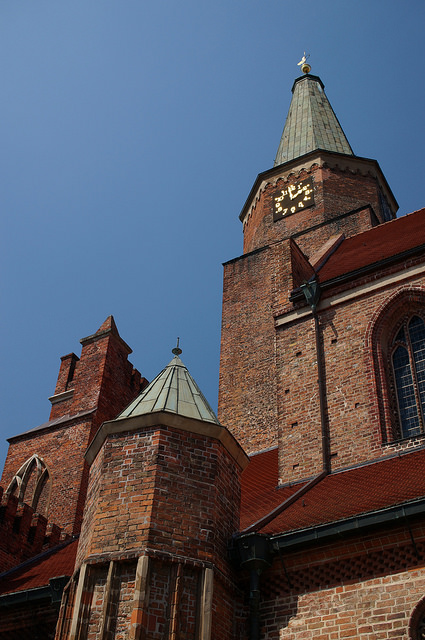
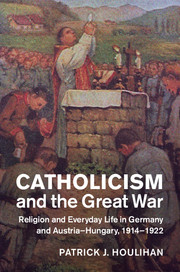 Houlihan’s argument is that conventional interpretations of religion in the First World War, which emphasize the secularizing effect of a shattering war experience as expressed in the voices of cultural modernists, do not capture the experiences of German and Austro-Hungarian Catholics. Rather, he asserts that Catholics adjusted to industrial warfare because their transnational faith and its practices helped them to cope relatively successfully with the upheaval and brutality of war—more successfully than Protestants, whose faith (in the case of Germany) was more closely tied to the defeated state.
Houlihan’s argument is that conventional interpretations of religion in the First World War, which emphasize the secularizing effect of a shattering war experience as expressed in the voices of cultural modernists, do not capture the experiences of German and Austro-Hungarian Catholics. Rather, he asserts that Catholics adjusted to industrial warfare because their transnational faith and its practices helped them to cope relatively successfully with the upheaval and brutality of war—more successfully than Protestants, whose faith (in the case of Germany) was more closely tied to the defeated state.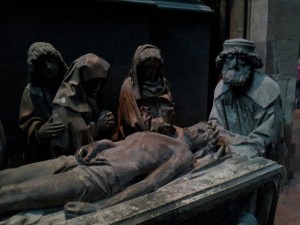
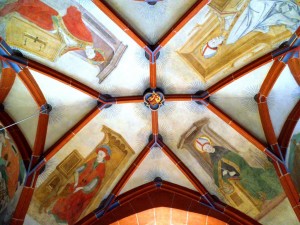
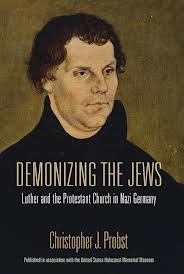 Christopher Probst has written an insightful analysis of the ways in which Protestant reformer Martin Luther’s anti-Jewish writings were used by German Protestants during the Third Reich. Fundamental to Probst’s work is his consistent use of Gavin Langmuir’s distinction between non-rational anti-Judaism (antipathy rooted in theological differences or other symbolic language which stand apart from and not against rational thought) and irrational antisemitism (antagonism rooted in factually untrue and slanderous accusations against Jews). In contrast to the idea that pre-modern anti-Jewish thought was generally religious and therefore anti-Judaic while modern anti-Jewish thought is political or racial and therefore antisemitic, Probst sees both anti-Judaic and antisemitic elements in the language of Luther and the twentieth-century German theologians, church leaders, and pastors who invoked him (3-4, 6, 17-19). In light of this, Demonizing the Jews is a book about historical continuity.
Christopher Probst has written an insightful analysis of the ways in which Protestant reformer Martin Luther’s anti-Jewish writings were used by German Protestants during the Third Reich. Fundamental to Probst’s work is his consistent use of Gavin Langmuir’s distinction between non-rational anti-Judaism (antipathy rooted in theological differences or other symbolic language which stand apart from and not against rational thought) and irrational antisemitism (antagonism rooted in factually untrue and slanderous accusations against Jews). In contrast to the idea that pre-modern anti-Jewish thought was generally religious and therefore anti-Judaic while modern anti-Jewish thought is political or racial and therefore antisemitic, Probst sees both anti-Judaic and antisemitic elements in the language of Luther and the twentieth-century German theologians, church leaders, and pastors who invoked him (3-4, 6, 17-19). In light of this, Demonizing the Jews is a book about historical continuity.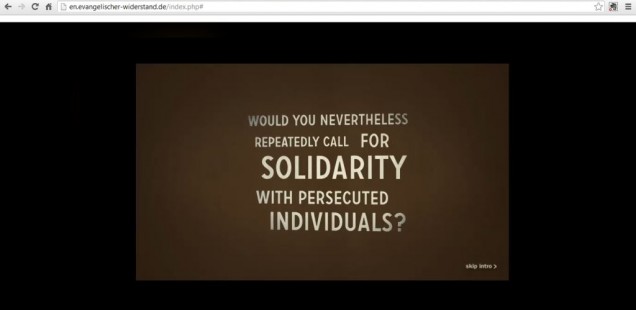 The interactive website “Evangelischer Widerstand” (
The interactive website “Evangelischer Widerstand” (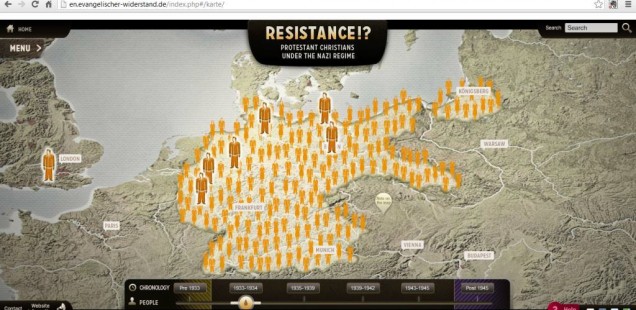 This is the website developed over the past couple of years by the Evangelische Arbeitsgemeinschaft für Kirchliche Zeitgeschichte (Protestant Working Group for Contemporary Church History) in Munich, under the leadership of Dr. Claudia Lepp, along with Drs. Siegfried Hermle, Harry Oelke, and a host of other notable German scholars. It is sponsored by the Evangelical Church in Germany, the Evangelical Lutheran Church in Bavaria, the Protestant Church in Hesse and Nassau, and the Köber Foundation of Hamburg, and supported by a long list of academics, Protestant notables, archives, memorial sites, and other institutions. It contains information on no less than three dozen (as of March 2013) individual or group resisters, along with a timeline, a series of fundamental questions, photos, documents and audio clips. It is a rich and growing set of resources, tied to a substantial bibliography of German-language publications on the topics of resistance and the German churches under Hitler. (Hopefully, over time, the bibliography will grow to include many of the important English-language studies on the German churches in the Nazi era.)
This is the website developed over the past couple of years by the Evangelische Arbeitsgemeinschaft für Kirchliche Zeitgeschichte (Protestant Working Group for Contemporary Church History) in Munich, under the leadership of Dr. Claudia Lepp, along with Drs. Siegfried Hermle, Harry Oelke, and a host of other notable German scholars. It is sponsored by the Evangelical Church in Germany, the Evangelical Lutheran Church in Bavaria, the Protestant Church in Hesse and Nassau, and the Köber Foundation of Hamburg, and supported by a long list of academics, Protestant notables, archives, memorial sites, and other institutions. It contains information on no less than three dozen (as of March 2013) individual or group resisters, along with a timeline, a series of fundamental questions, photos, documents and audio clips. It is a rich and growing set of resources, tied to a substantial bibliography of German-language publications on the topics of resistance and the German churches under Hitler. (Hopefully, over time, the bibliography will grow to include many of the important English-language studies on the German churches in the Nazi era.)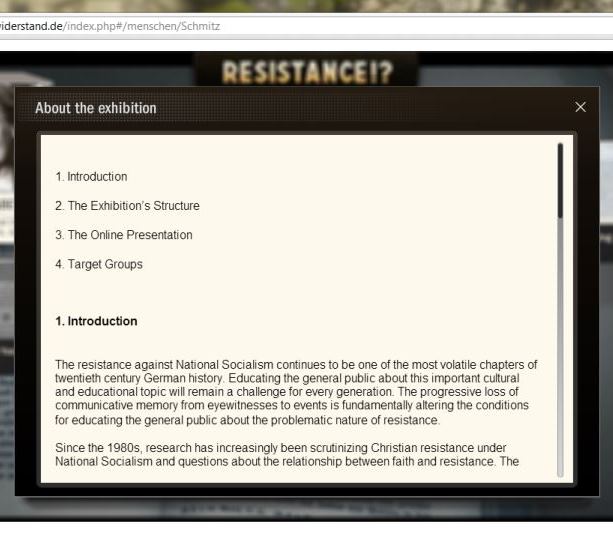 In the “About the exhibition” section of the site, Claudia Lepp and her colleagues explain their historical assumptions and methodology. They argue that the resistance against National Socialism “continues to be one of the most volatile chapters of twentieth century German history,” express their concern about “the progressive loss of communicative memory from eyewitnesses to events,” and note “the problematic nature of resistance.” Delving into the historiography of the German churches under Nazism, they identify a shift during the 1980s away from a focus on the Confessing Church and towards four new issues: 1) the role of resistance in the everyday life of Christian congregations and the question of who was motivated by their Christian faith to aid the victims of persecution; 2) the significance of “less noted” groups like the Religious Socialists, liberal Christians, Christians in the National Committee for Free Germany, conscientious objectors and those who deserted on account of their Christian faith; 3) the personal faith of resistance members and its relationship to their ethical and political thinking; and 4) the proper historical presentation of resistance “detached from forms of heroization.”
In the “About the exhibition” section of the site, Claudia Lepp and her colleagues explain their historical assumptions and methodology. They argue that the resistance against National Socialism “continues to be one of the most volatile chapters of twentieth century German history,” express their concern about “the progressive loss of communicative memory from eyewitnesses to events,” and note “the problematic nature of resistance.” Delving into the historiography of the German churches under Nazism, they identify a shift during the 1980s away from a focus on the Confessing Church and towards four new issues: 1) the role of resistance in the everyday life of Christian congregations and the question of who was motivated by their Christian faith to aid the victims of persecution; 2) the significance of “less noted” groups like the Religious Socialists, liberal Christians, Christians in the National Committee for Free Germany, conscientious objectors and those who deserted on account of their Christian faith; 3) the personal faith of resistance members and its relationship to their ethical and political thinking; and 4) the proper historical presentation of resistance “detached from forms of heroization.”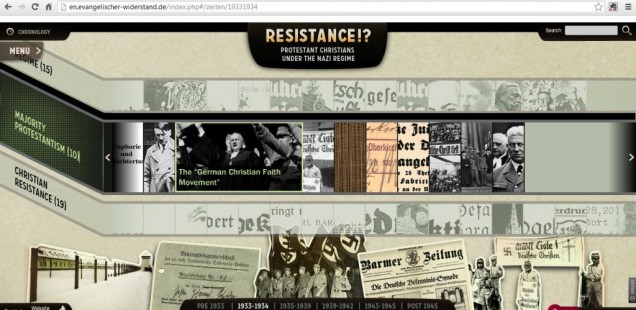 A similar analysis could be made of the timeline. Here the web historians offer up three streams of articles—on the “Regime,” on “Majority Protestantism,” and on “Christian Resistance.” There are entries about Hitler’s misleading pro-Christian statements, the German Christian Faith Movement, and other aspects of the history of Protestant collaboration with the Hitler state. Still, in the crucial 1933-1934 section, the 19 articles devoted to aspects of Christian Resistance are almost double the 10 entries given over to the compromised majority Protestants, once more creating the impression that Christian Resistance was, in fact, the most obvious Christian response to the Nazi dictatorship.
A similar analysis could be made of the timeline. Here the web historians offer up three streams of articles—on the “Regime,” on “Majority Protestantism,” and on “Christian Resistance.” There are entries about Hitler’s misleading pro-Christian statements, the German Christian Faith Movement, and other aspects of the history of Protestant collaboration with the Hitler state. Still, in the crucial 1933-1934 section, the 19 articles devoted to aspects of Christian Resistance are almost double the 10 entries given over to the compromised majority Protestants, once more creating the impression that Christian Resistance was, in fact, the most obvious Christian response to the Nazi dictatorship.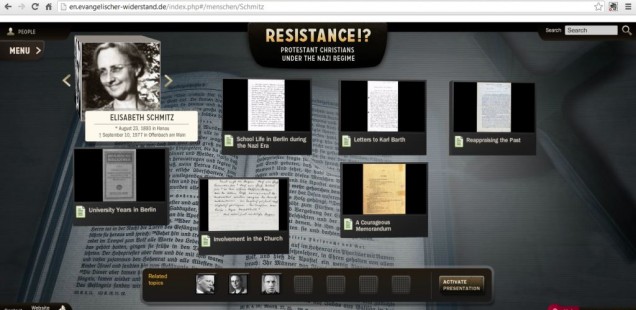 Because of these two weaknesses in the website’s approach to presenting the history of the German churches in the Third Reich, “Evangelischer Widerstand” works best when it tells the stories of the heroic, deeply-principled Christians who acted decisively against the regime and its policies. Elisabeth Schmitz is a good example. Just as Manfred Gailus has recently argued in his fine history
Because of these two weaknesses in the website’s approach to presenting the history of the German churches in the Third Reich, “Evangelischer Widerstand” works best when it tells the stories of the heroic, deeply-principled Christians who acted decisively against the regime and its policies. Elisabeth Schmitz is a good example. Just as Manfred Gailus has recently argued in his fine history 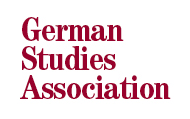 Once again this past year, the German Studies Association conference included a number of interesting panels or papers devoted to contemporary church history.
Once again this past year, the German Studies Association conference included a number of interesting panels or papers devoted to contemporary church history.